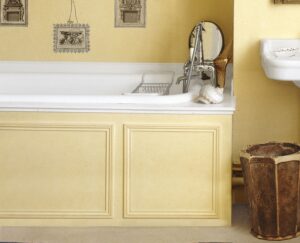
When building a house and connecting it to centralized heating, cast iron radiators are used. Such products are durable and reliable: in old buildings, you can find batteries that have served for 30-50 years.
If earlier no one thought much about the beauty of the room, then when carrying out modern repairs, the living space owners often prefer to replace the old batteries with new ones. This article will consider the main types of modern radiators, their features, and their parameters.
What Factors Should You Consider When Choosing a Heating Radiator?
When choosing a heating radiator, you should consider the size of your room, the type of heating system you have, and how much heat you need. You also need to consider the price and warranty of the radiator.
Types of Heating Radiators
Cast Iron Radiator
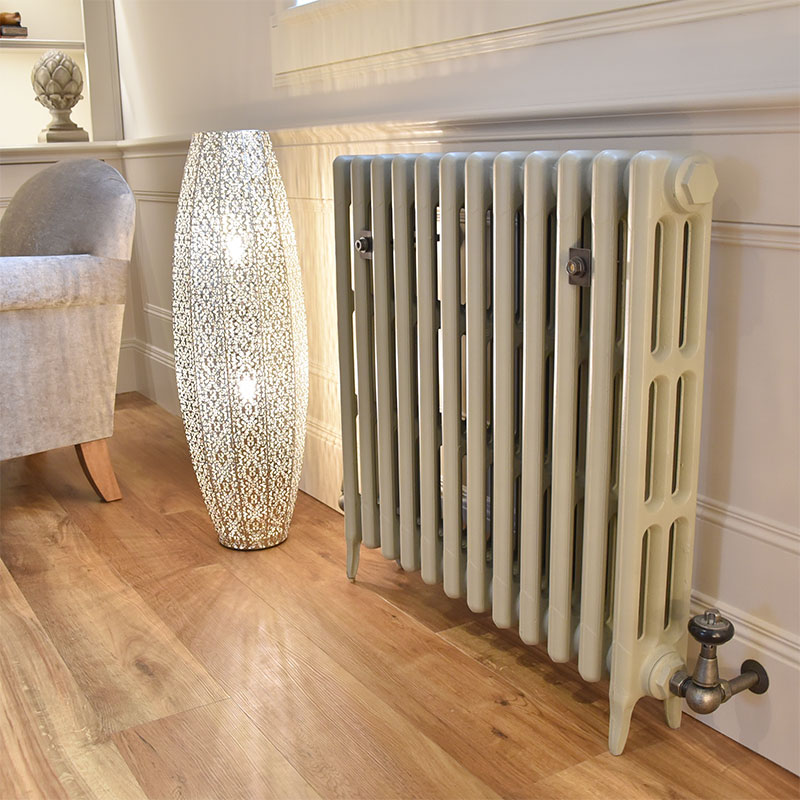
Cast iron batteries do not lose their popularity due to the following advantages:
- Durability and reliability.
- Cast iron does not rust.
- Suitable for connection to centralized and autonomous heating systems.
- Maintain temperature for a long time (thermal inertness).
And also, the advantages include a large internal section of the sections, which reduces the risk of clogging.
The disadvantages of cast iron products include the following factors:
- Significant weight complicates transportation and installation.
- Warm-up for a long time when the heating is started for the first time (inertia).
- Cast iron is a somewhat brittle metal that a strong water hammer can damage.
In addition to classic batteries, manufacturers offer products made in a more modern form and a retro style, which are suitable for designer renovations and can decorate any interior.
Characteristics of cast iron radiators:
- Heat transfer per section is 100–160 watts.
- Service life: over 30 years.
- Working pressure: up to 18–20 atmospheres.
Aluminum Radiator
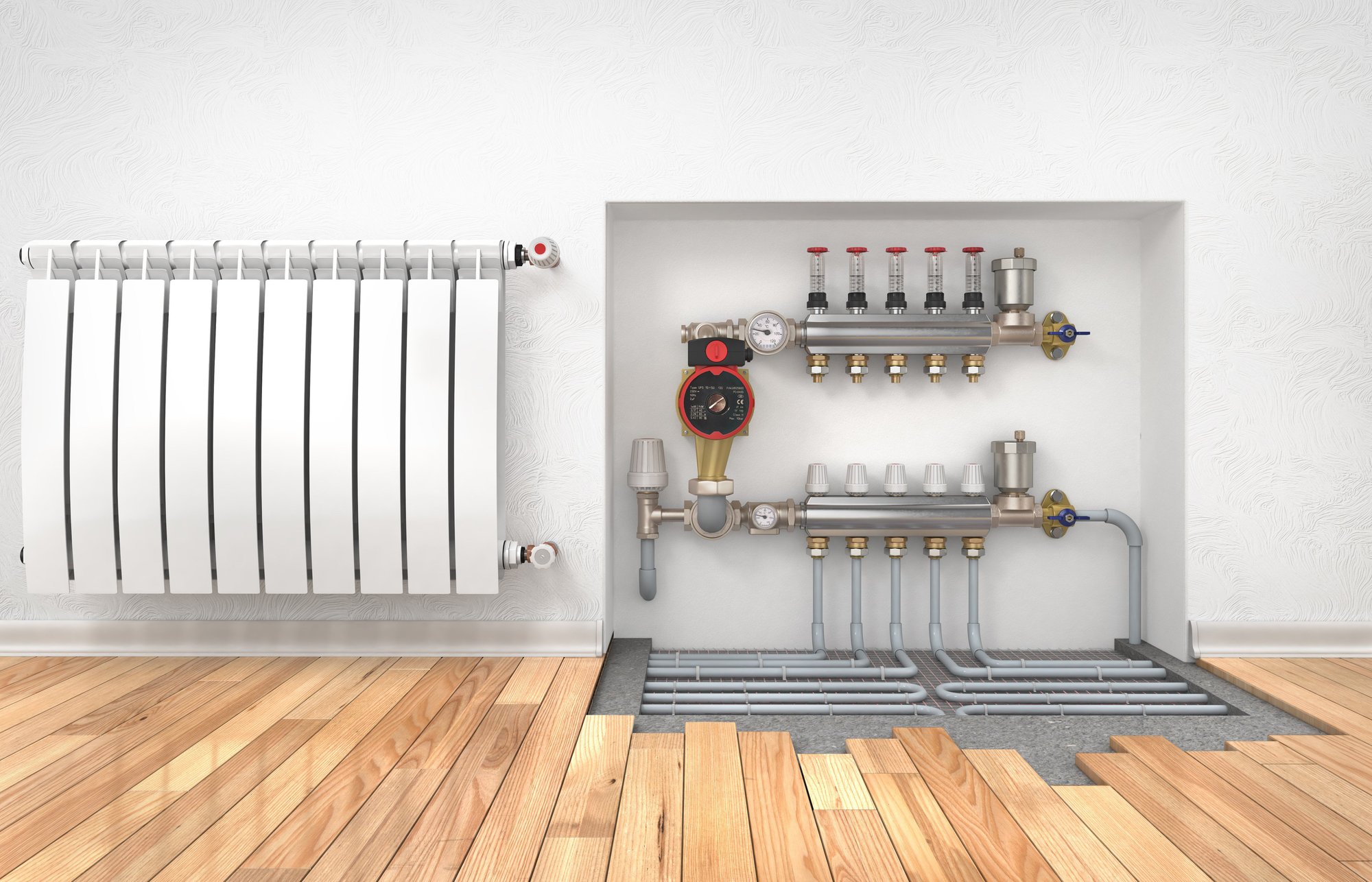
Batteries made of aluminum are not recommended for installation in apartment buildings due to the low quality of the coolant, which leads to chemical reactions inside the batteries and their rapid failure. Such radiators are suitable for installation in private houses with individual heating since, in small systems, it is easier to control the quality of the coolant.
According to the type of construction and manufacturing method, aluminum radiators are divided into two types:
- Extrusion. Individual parts of the sections are made on an extruder, after which they are glued and pressed. We cannot disassemble batteries of this type – this is their main disadvantage.
- Cast. In this case, whole sections are cast from an aluminum alloy in production, then connected. This manufacturing method allows you to assemble a radiator with any number of units and, if necessary, add or subtract several areas.
The advantages of aluminum batteries include the following characteristics:
- Low weight, which facilitates installation.
- High heat-conducting and heat-transfer characteristics of aluminum.
- Low cost.
- Attractive design.
Among the shortcomings, aluminum’s sensitivity to the coolant’s quality, weak resistance to mechanical damage and water hammer, a short service life (about 15 years), and weak convection are noted.
Characteristics of aluminum radiators:
- Heat transfer per section is from 82 to 200 watts.
- Service life: 15–20 years.
- Working pressure: 5-16 atmospheres.
Bimetallic Radiator
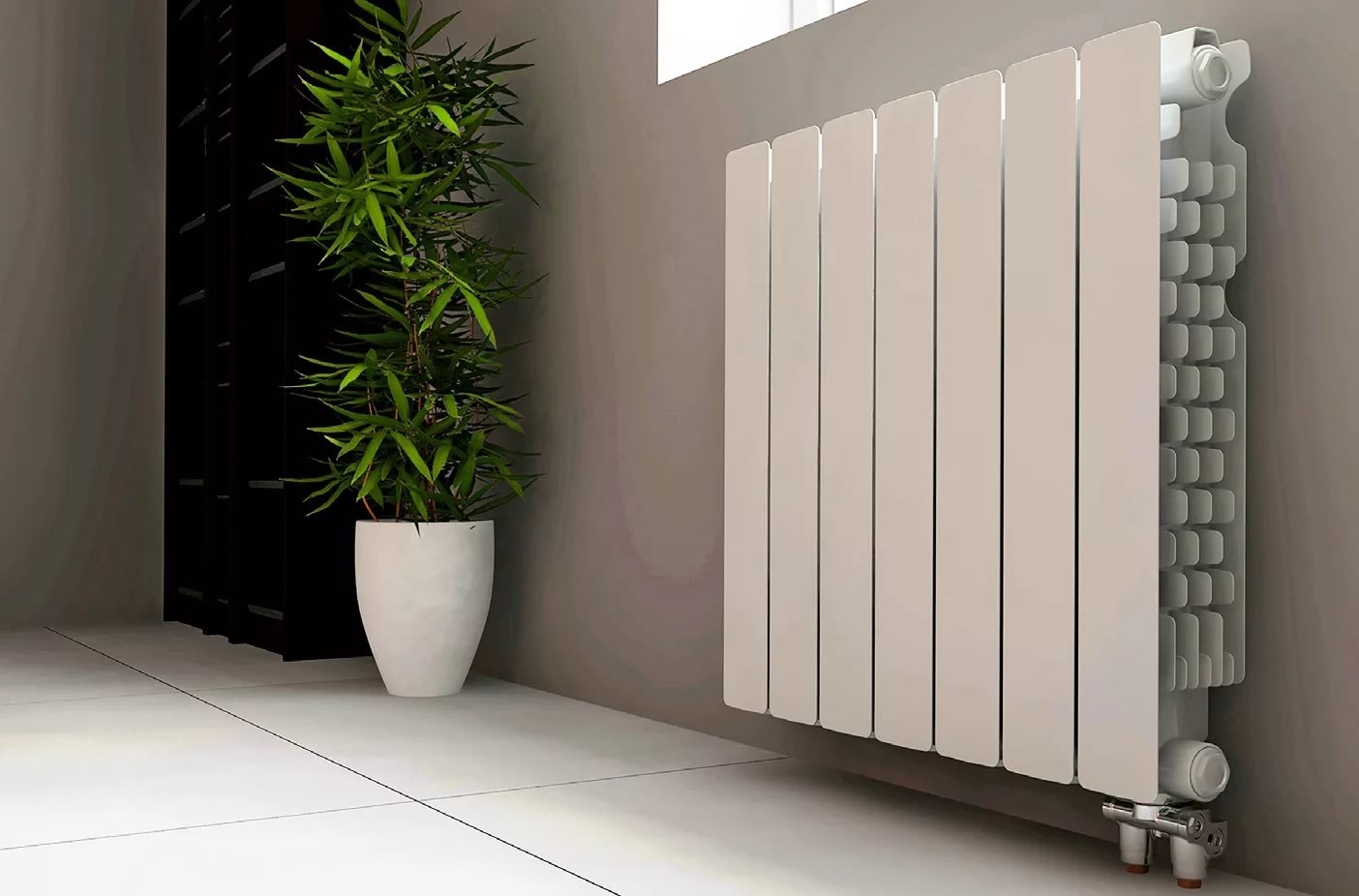
Such products are made of two metals: the body is cast from aluminum and the channels through which the coolant moves are made of steel. There are two types:
- The entire internal manifold is made of steel. Such radiators are very reliable, withstand water shocks well, and withstand high pressure: sectional up to 20, and monolithic up to 50 atmospheres.
- Only the vertical channel of the radiator is reinforced with a steel insert. It reduces the performance and durability of the battery: such products are often called pseudo-bimetallic. We can not recommend installing them in apartment buildings.
This product combines the advantages of both materials:
- High level of heat transfer.
- Resistance to low-quality coolant, water hammer, and mechanical stress.
- Lightweight and easy installation.
- Modern design.
The disadvantages include the high price of bimetallic products. And also, when draining water from the system, the steel core corrodes.
Characteristics of bimetallic radiators:
- Heat transfer per section is 150-180 watts.
- Service life: 20-25 years.
- Working pressure from 10 to 40 atmospheres, depending on the thickness of the steel insert.
Steel Radiator
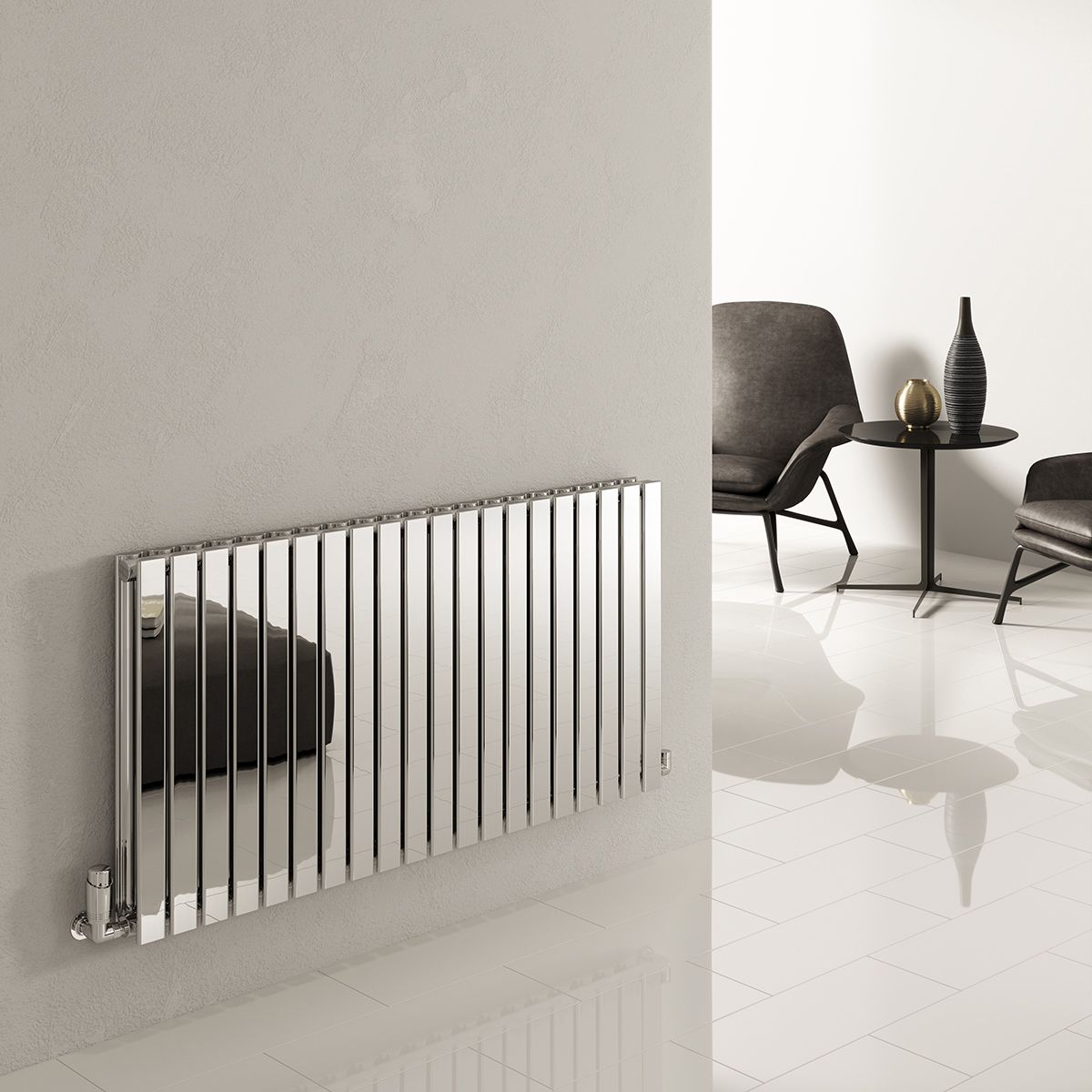
Steel radiators are reliable, lightweight, and durable products. Available in two types:
- Panel. We call such radiators water convectors, as they have high air convection. Their total efficiency of radiant and convection heat transfer is about 75% – the highest of all types of radiators. They are made of stamped sheets with shaped grooves for channels. There are metal fins inside the structure, which increase heat transfer and increase the convection movement of air through the battery.
- Tubular. In such models, the lower and upper manifolds are connected by pipes. In addition to the standard installation under the window, tubular radiators are also placed in bathrooms (heated towel rails).
The advantages of steel products include their high thermal conductivity and heat transfer, low cost, and ease of installation.
Among the disadvantages is the tendency to corrosion, which reduces the service life, which is about 15 years on average.
Characteristics of steel radiators:
- Heat transfer per section is 1200-1600 watts.
- Service life: 15-25 years.
- Working pressure: from 6 to 15 atmospheres.
Which Heating Radiator for an Apartment or a Private House is Better to Choose?
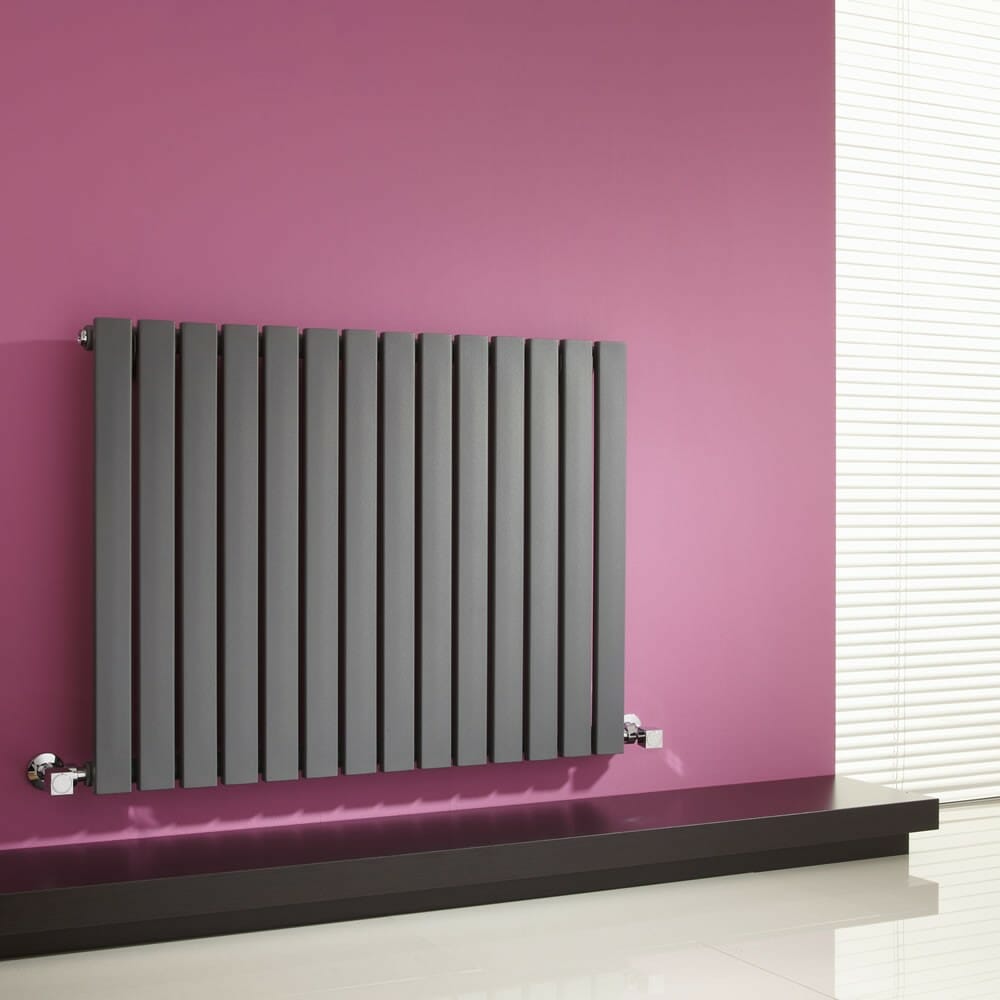
In terms of price, steel panels and standard cast iron batteries are considered the cheapest. Further, in the increasing average price are aluminum, the most expensive are designer cast iron, steel tubular, and bimetallic radiators.
The appearance of the radiators is selected based on personal preferences and taste, as well as taking into account the design style of a particular room.
For apartments with centralized heating, bimetallic radiators are best suited. In second place are cast iron and steel panel panels, and it is not recommended to install aluminum batteries.
For autonomous systems, in principle, any type of heating radiator is suitable. But in terms of the ratio of price, heat transfer, appearance, and quality, we can put aluminum batteries first. At the same time, it is impractical to install bimetallic products due to their high price.
How to Install a Heating Radiator
When you are thinking about installing a heating radiator, there are a few things to consider. The following tips will help you choose the right radiator for your needs.
1. Size and shape.
Heating radiators come in many different sizes and shapes, so it is important to choose one that will fit your space properly. If you have a large room, for example, consider getting a large radiator. On the other hand, if you only have a small room, you may want to get a small radiator. There are also shaped radiators, such as octagons and circles, that can make your room look more organized.
2. Material.
Radiators come in different materials, including metal, plastic, and wood. Metal radiators are usually the most expensive but are also the most durable. Plastic radiators are cheaper but may not be as durable. Wood radiators are the cheapest but may not be as durable or as warm as metal or plastic radiators.
3. Installation options.
Heating radiators come with different installation options, such as wall mounts or floor mounts. Wall mounts are usually easier to install than floor mounts.
How to Use The Thermostat on a Heating Radiator
When it comes to heating your home, there are a few things you need to know about thermostats. Your first step is to choose the right radiator for your needs. Here are a few tips to help you get started.
First, consider the size of your room. Heating radiators come in different sizes, so make sure you choose the one that’s right for your space. Heating radiators with larger bodies heat up faster, while radiators with smaller dimensions are better for smaller rooms.
Next, think about how often you’ll use the radiator. Some radiators have automatic shut-off features that turn off the unit after a certain amount of time has passed without being used. Choose a radiator with this feature if you plan on leaving your home for an extended period of time and don’t want to waste energy keeping the radiator on.
And finally, be sure to check the thermostat rating. Not all radiators come with a thermostat – choose one that does if you’re not familiar with how to operate one. A high-rated thermostat will save you money in energy costs and will keep your room at a more consistent temperature.
How to Clean a Heating Radiator
If you have a heating radiator, it’s important to keep it clean. Heating radiators work by transferring heat from the hot water in the tank to the room. Dirty heating radiators won’t transfer heat as well, which can lead to cold spots in your home. Here’s how to clean a heating radiator:
- Turn off the power to your heating radiator and disconnect any hoses or wires connected to it.
- Use a vacuum cleaner to remove all of the dust and debris from the radiator. Be sure to move around all of the fins and crevices.
- Pour a pot of boiling water onto the floor of your cleaning area. Add a cup of white vinegar or soap scum eliminator and mix well.
- lace the heating radiator into the boiling water mixture and let it sit for 10 minutes.
- Remove the radiator from the mixture and let it dry completely.



